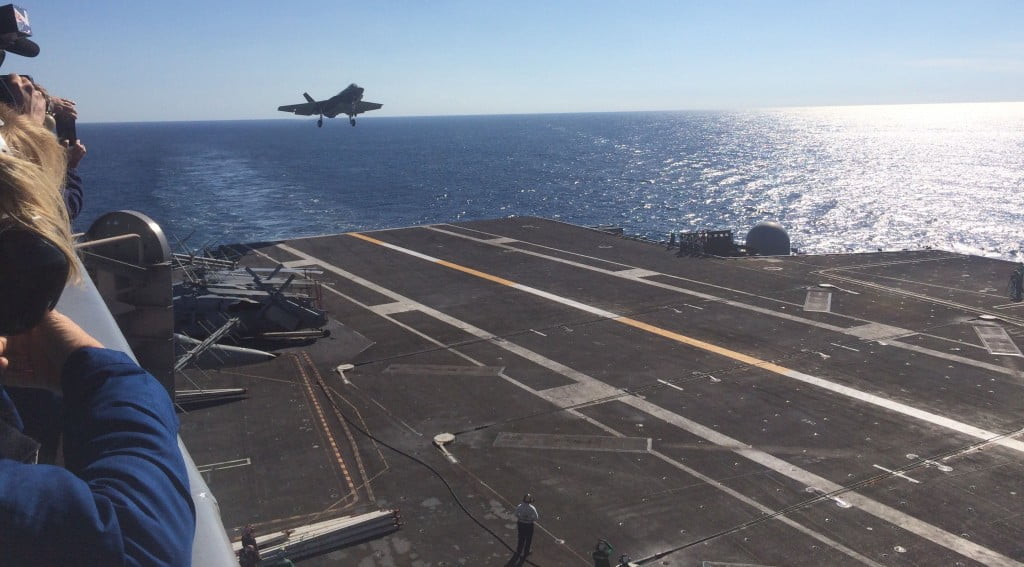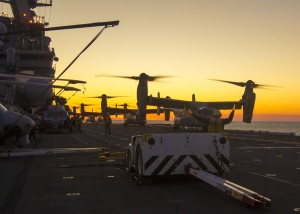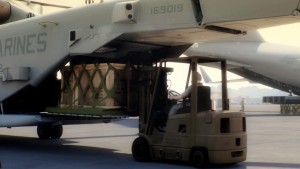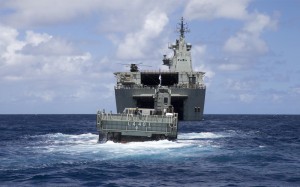2016-03-16 By Robbin Laird
The first of a two day conference on Air Power hosted by the Royal Australian Air Force featured a keynote presentation by the Minister of Defence.
This represented her first major policy statement after the release of the White Paper and associated documents.
For an American attending the conference what was clear was that the Minister has followed defense issues for a long time and has a demonstrated mastery of the issues.
This was no walking through a speech written by others, but a clear statement of how she saw the issues as part of the current government.
I have read through the White Paper documents and have written pieces providing some initial analyses.
Listening to the Minister certainly brought both context and emphasis to the White Paper.

One issue which jumped out was a clear statement of how the strategic environment had changed and the importance of Australia focusing its attention on modernizing defense and enhancing its capabilities to work with core allies, including its regional partners.
There was no free ride issue which one often sees with too many NATO partners.
A second issue was underscoring the importance of shaping an integrated force that was capable of flexible and agile operations, and with a high demand humanitarian work load for the Australian Defence Force, this means across the spectrum of operations.
A third issue – after emphasizing IT and networks – was a clear understanding that a modernized force may be great but without the proper infrastructure, including logistics, the modernization effort would not really have its intended effects.
It is of course not just improved ICT networks and systems and capability that will underpin our future Air Force over the next two decades.
One of the defining features of the 2016 Defence White Paper and Integrated Investment Program is the renewed focus on enabling capabilities.
In fact, 25 per cent of the Integrated Investment Program is allocated to the enabling projects, which help to bind our capabilities – whether it’s our airfields, our bases, our wharves, our ordnance facilities or our logistics systems, just to name several.
I have always felt that understanding the central role of logistics is a key discriminator between those who actually understand defense operations and those who do not.
Clearly, the Minister put herself on the side of defense professionals in her emphasis on funding the enabling factors.
2016 Royal Australian Air Force Air Power Conference – National Convention Centre, ACT
Tuesday, 15 March 2016
Good morning ladies and gentlemen. Let me begin by acknowledging the traditional owners of the land on which we meet this morning and pay my respects to their elders, past, present and future.
Chief of Air Force, Air Marshal Davies, I thank you very much for the invitation to address this important event and for your kind words of introduction. I echo your welcome to all delegates to this conference. In particular, I extend a very warm welcome to the many visiting Chiefs of Air Forces and international delegations, particularly also to my Ministerial colleague, the Minister for Defence Materiel, Dan Tehan, to our important partners from industry and to our many other distinguished guests and invited speakers.
As the Chief of Air Force said, the fact that more than 1,000 delegates are gathered here today, including a significant number of international Air Force Chiefs, a contingent of United States Commanders in the Pacific, and senior Air Power representatives from around the world, does attest to the very high regard in which this conference is held. I welcome you all to our Nation’s capital.
I say in advance, before the morning unfolds too much further, that for me and for Minister Tehan, this is a Parliamentary sitting day. Not all of you have Ministers who are parts of your Parliament; some of you have Cabinets which sit separately from your Parliaments – or elected representatives. But for us, it is a case of be there in person to vote or else, as required by one’s leaders. So we will both be departing relatively soon after our speech this morning. Please don’t take that as a lack of interest, if I was choosing I promise you I would be spending a lot more time here than I would in my Parliamentary chamber today.
Ladies and gentlemen, this is a very important time for the Australian Department of Defence and also the Royal Australian Air Force. Three weeks ago, Prime Minister Malcolm Turnbull and I released the 2016 Defence White Paper. This document is supported by a fully costed Integrated Investment Program and a Defence Industry Policy Statement. The White Paper sets out the Turnbull Government’s comprehensive and responsible long term plan to ensure Australia’s national security and to create a more capable, agile and potent ADF – the RAAF is at the heart of this plan.
Australia has long seen itself as the ‘lucky country’. Our richness in natural resources, geographic location, our historical and contemporary relationships, and a well educated, innovative and productive population have allowed us to benefit from the shift in global economic power to the Indo-Pacific region. However, as the White Paper makes clear, the parallel shift in strategic power makes for a more complex and demanding strategic environment. This may, in turn, give rise to a broader range of security challenges.
With our international partners, Australia works therefore to foster a rules-based global order. If Australia is to grasp the opportunities available to us and manage the risks, the Turnbull Government recognises that the ADF, including our Air Force, must become more capable, agile and potent. Furthermore we recognise that Australia’s strong network of regional and global Defence relationships will be even more important to us in the future.
So, in the White Paper for the first time we have prioritised and funded Defence’s international engagement as a core Defence function. The RAAF already has – and it will grow – a core role in our international engagement. Through the capability plans in the White Paper, the RAAF’s alibility to project its air power further across the globe will be strengthened.
The importance, for example, of our role in our region and, in this instance, in humanitarian assistance and disaster relief has been underscored by the devastating effects of Cyclone Winston in Fiji. Our RAAF C-17s carrying supplies and Army MRH-90 helicopters were among the earliest international responders to reach the devastated islands. The ADF continues to provide invaluable support to Fiji through operation FIJI ASSIST, with HMAS Canberra currently providing essential support on deployment, while the Army’s 2nd Combat Engineer Regiment is assisting in helping the nation to rebuild its critical infrastructure.
Over the next two decades Air Force will also be equipped with new and more capable platforms to patrol and respond on Australia’s vast maritime approaches. As foreshadowed in the White Paper, I can indicate today that the Government has approved the acquisition of four additional P-8A Poseidon maritime surveillance and response aircraft, bringing the total number of P-8As on order to 12. The Government is also considering the acquisition of seven MQ-4C Triton unmanned aircraft systems. These two platforms will replace the ageing AP-3C Orion aircraft, giving Australia a greater maritime intelligence, surveillance, reconnaissance and response capacity.
The first of the Poseidons is expected to be delivered late this year and 12 aircraft will be in service by 2022. Pending government approval a further three aircraft are planned to enter service late in the 2020s and the Triton is planned to be introduced into service in 2023. While the Orion fleet has performed exceptionally on operations throughout its distinguished service, the last of these aircraft will be almost 40 years old when they retire from service.
Ladies and gentlemen, Air Force is already operating some of the sophisticated platforms that will contribute to the networked joint force the White Paper will deliver. I had the opportunity to fly aboard and see first-hand the impressive capabilities of the Wedgetail Airborne Early Warning and Control aircraft and crew, which is currently part of our contribution to the campaign against Daesh in Iraq and Syria.
Australia’s Air Task Group forms the combat element of the Turnbull Government’s contribution to the Coalition efforts targeting Daesh. This Task Group, with its Super Hornets, Hornets, Wedgetail and KC-30 tanker aircraft, is a strong combat capability. In particular, it’s the interoperability of our aircraft, including our KC-30 tanker aircraft and Wedgetail, with our coalition partners that is bringing unique capabilities to the air campaign.
The Chief of the Defence Force, Mark Binskin, has previously remarked on the positive feedback he has received regarding the impressive capability of our Wedgetail aircraft. Our KC-30s and our C-17s are at the centre of our ability for our Air Force to deploy across the globe and to work with our international partners to promote our interests. That capability will be further increased with the acquisition of a further two KC-30s, bringing the total number to seven, further increasing our ability to project our air power and sustain humanitarian, combat, and search and rescue operations.
Over the next decade, the Australian Air Force’s capability will be further strengthened with the introduction into service of the Joint Strike Fighter, the Growler Electronic Attack aircraft and armed unmanned air systems. As the development of the Joint Strike Fighter continues, the pace of testing and evaluation is increasing and I am pleased that another two Australian pilots have recently been relocated to the United States to begin their training. Australia’s JSF aircraft remain on track to arrive in Australia in 2018 with Initial Operational Capability scheduled for 2021.
To maximise the capabilities of our current and future Air Force our systems must be networked and integrated to a degree not previously achieved. Air, land and maritime forces need to exploit the high level of connectivity made possible by use of systems uniting them through the space and cyber domains. Much work has already begun in this regard under Plan Jericho, to which the Chief of Air Force referred, to ensure we have a fully networked joint future force across air, space, electromagnetic and cyber.
With its modernised inventory, Air Force will introduce and develop capabilities that will enhance its ability to work jointly with its sister Forces, in many cases before the systems they will network with enter service with Army and Navy. The work being undertaken by Air Force now in exploring the “art of the possible” and reducing risk through experimentation and trials means that the benefits of a joint force will be more rapidly realised once the networked systems committed to in the White Paper enter Army and Navy service.
As the White Paper details, Defence’s ICT systems have not necessarily kept pace with the rapid advances in technology. To address this, we are making a significant commitment to modernising and transforming Defence’s communications and information systems so that we can take advantage of the changes and improvements in technology.
The Government also acknowledges that the greater our reliance on information systems, the greater the potential risks from cyberattacks. As a result we have also provided for significant investment in cyber capabilities to safeguard government agencies and critical infrastructure against cyberattack.
It is of course not just improved ICT networks and systems and capability that will underpin our future Air Force over the next two decades. One of the defining features of the 2016 Defence White Paper and Integrated Investment Program is the renewed focus on enabling capabilities. In fact, 25 per cent of the Integrated Investment Program is allocated to the enabling projects, which help to bind our capabilities – whether it’s our airfields, our bases, our wharves, our ordnance facilities or our logistics systems, just to name several.
We have upgrades underway at a number of airfields to accommodate some of our new capabilities including RAAF Base Tindal, Williamtown and Darwin. Over the next twenty years in fact, we will spend up to $3 billion in upgrading our airfields across Australia to ensure that our next generation capabilities are properly supported. Without the attention and commitment to deliver these enabling systems, the force multiplying effect of a joint force will not be realised. I know that air forces love their technology, but without the right people, technology can’t, doesn’t become capability.
In Australia, which is a multi-cultural society with a relatively modest population and a vast territory – that vast territory is landmass alone, close in size to that of all of Europe – but with a population less than one third of that of Germany’s. So, to deliver the capabilities of the technologically advanced Future Force outlined in the White Paper, the Government has also committed to grow the uniformed Defence Force to around 62,400 people over the next decade, which will be its largest size in two decades. To attract and sustain this expanded military work force, Defence must recruit and retain its workforce from across that very diverse society; a society in which more than a quarter of all people were born overseas, and over half of which are female.
In relation to women in the Air Force, they currently make up more than 18.5 per cent of Air Force personnel, with Air Force on track to reach its target of 25 per cent female representation by 2023. A number of initiatives are in place to embrace a more inclusive culture within Defence and significant work has been done to remove barriers to the career progression and employment of women, but there are still challenges, still barriers.
Australia has never had a female fighter pilot, although I am pleased to hear that may change very soon, with one female pilot in training right now to become a fast jet pilot. The challenge, though, is to ensure that she’s not the only one, and that there is a steady stream of young women entering these programs of which they’ve not traditionally been part.
We are also addressing the under representation of Indigenous Australians and culturally diverse sections of our society in the ADF. Yesterday I was at ‘the home of the soldier’ – Kapooka, our Army recruiting base – to launch Defence Force Recruiting’s new Indigenous recruitment campaign, which was another important step towards creating an ADF that reflects the community from which it is recruited and which it is entrusted to protect. So that recruiting program – #seeyourself – displays commitment of three of four young Indigenous Australians who’ve been in the ADF for 25 – 8 – 10 years themselves across the three services and asks the viewer to ‘see yourself’ in their jobs, in their roles, and it does it in their own words. It’s a very impactful, very powerful message to young Indigenous Australians that the Australian Defence Force is a great place to be and to come and work.
Ladies and gentlemen, as I’ve mentioned already today, the resources that this workforce will have at its disposal – the aircraft, the vessels, the vehicles, the technology and the information systems will be increasingly sophisticated. The Turnbull Government recognises that a strong, innovative and competitive Australian Defence Force industry is essential.
The Defence Industry Policy Statement, released alongside the White Paper, hasn’t been far from my side over the past three weeks. This document is designed to reset the relationship between industry and Defence; to maximise industry’s innovation potential and to ensure Defence can benefit from, frankly, some amazing capabilities being developed right here in Australia.
One of the key initiatives of the Industry Policy Statement is the Centre for Defence Industry Capability, which the Prime Minister and the Minister for Industry and I announced last week, will be centred in Adelaide. It will have national reach and it will ensure that the defence industry knows what Defence’s capability priorities are and importantly, it will help Defence identify what industry can offer because the Defence-Industry relationship for us is very much a two-way street.
The Joint Strike Fighter program is one area in which we have seen Australian industry compete and access export markets already worth $500 million, which is expected to rise to more than $2 billion by 2022-23. Over the last few months I’ve been lucky enough to visit a number of impressive small-to-medium enterprises that have developed – or are in the process of developing – cutting edge technologies that provide our Australian Defence Force with unique capabilities. The Centre for Defence Industry Capability will help foster the relationship with industry to build its capacity to drive innovation and to open export markets, so that we can find and help develop the next great Australian innovators and I know there are very many of them around this country.
Capability, agility, potency; these are the attributes the Government has invested in enhancing through its balanced approach to the future development of the Australian Defence Force as outlined in the 2016 White Paper. Cutting edge, networked, and integrated technology; an expanded and empowered workforce; and an engaged industrial base are the means of its delivery. And our Air Force is very much at the centre of our high-technology, Future Force.
Air Marshal Davies, I thank you very much for inviting me to address the Air Force’s Air Power Conference. I wish you and all of the participants, presenters and delegates a very productive conference and thank you for the opportunity to be here this morning.
















